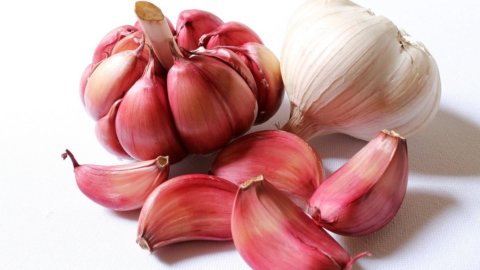Its flavor is intense, spicy and highly appreciated in gastronomy. Nubia red garlic has a much higher than average allicin content (organic sulfur compound) and this is what gives it its particular aroma. Unlike the classic white garlic, the red one is smaller, narrow, the outer skin is deep red and usually each head contains an average of 12 cloves. Protected by the Slow Food brand, the red garlic of Nubia goes very well with typical dishes of the Trapani cuisine, both raw and cooked, as a flavoring or as a main ingredient.
It is included, together with the Paceco garlic and the Trapani garlic, among the traditional Sicilian agri-food products recognized by the Ministry of Agricultural, Food and Forestry Policies, on a proposal from the Sicilian Region. In 2002 he also obtained the recognition of Slow Food Presidium and the procedure for granting the Protected Designation of Origin (PDO) brand and for the granting procedure for the Protected Geographical Indication (PGI) brand has been underway for three years.
While the 2020 production was an excellent year from a qualitative point of view, that of 2021 is in a dramatic situation and there is the risk of losing the entire year. In the sowing months of the year marked by the pandemic it never rained and some seedlings did not overcome the arid conditions, thus about 20% of the harvest was lost but quality gained. According to one of the 4 members of the red agricultural cooperative of Nubia, John Manuguerra, the credit goes to the sirocco which helped to "clean" the plants in a natural way, avoiding any treatment against rust. The situation completely reversed in 2021, due to the abundant and violent rains that have hit the Trapani area in recent months, making the state of the land a disaster and preventing preparation for sowing (between October and November), even before of the actual sowing.
CULTIVATION TECHNIQUES
The cultivation of Nubia red garlic has a deep-rooted tradition, still practiced today with traditional methods by small Sicilian companies mainly family-run: in all about 90 hectares but currently about 15 are cultivated, in rotation with melon, broad beans and durum wheat. It is grown in dry, dark and clayey soils surrounded by salt pans, within the Saline Natural Reserve of Trapani and Paceco but also in the neighboring municipalities: Erice, Buseto Palizzolo, Valderice and Marsala. Yes sowing at the end of autumn (between December and January), manually, using wedges from bulbs shelled or "sliced" from the outer tunics which are placed in furrows. There collection, always manual, takes place between May / June in the coolest hours of the day since the humidity of the leaves facilitates the work of intertwining the bulbs.
Tradition has it that it is packaged in very large braids (up to 50 bulbs) and that these are hung in front of the balconies of the houses. Depending on the diameter of the bulbs, the braids take on different names: Red spoon (50mm), Current (40mm), Cucchiscedda (30 mm) and Mazzunedda (20-25). For some years now, to meet the needs of the market, smaller pieces have also been produced with a single braid and a smaller number of bulbs such as Sleeve, pentaglio and Flower of Nubia.
NUTRITIONAL PROPERTIES
Garlic in general brings many benefits to our body. Antioxidant e pesticide, garlic is an excellent ally of the liver as it has an action purifying e detoxifying. It prevents liver disease, helps lower blood pressure and can be considered a natural antithrombotic as it has a vasodilatory effect. Compared to traditional garlic, Nubia's red garlic has a higher concentration of organic sulfur compounds, sulphur, iodine and silicon. It is very rich in vitamin C, thiamine and riboflavin, powerful antioxidants necessary for our overall health. Furthermore, this variety is widely used in natural medicine to prepare garlic tablets or extracts.
USE IN THE KITCHEN
Garlic is usually used as an ingredient for sautéed dishes, such as fish soup, pasta with clams, larded rabbit and baked fish. For example, Trapani cuisine is the main ingredient in the preparation of pesto sauce in the Trapani's style in dialect pasta cull'àgghia, i.e. with garlic, (made with crushed garlic, basil, almonds, tomato, salt, pepper and extra virgin olive oil), or in pizza rianata and bruschetta. Not only cooked, garlic can be used raw as a condiment to flavor vegetables such as zucchini, aubergines and grilled peppers.





